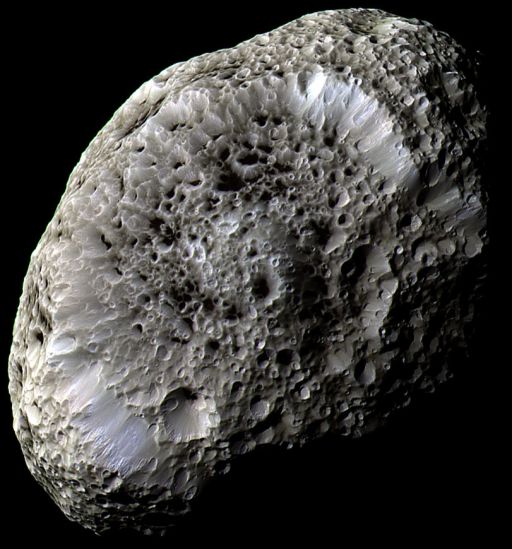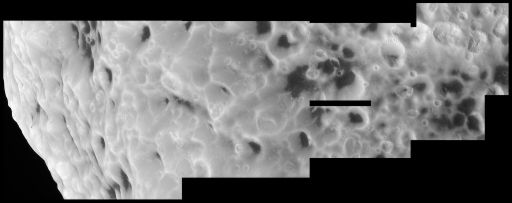Emily Lakdawalla • Oct 01, 2005
Amazing views of Hyperion
I've finally worked my way through all of the Hyperion images that were returned from the last flyby. It's a wonderful data set. I put a page together about all of the images, but...it's on the new website, which you can't see yet (sorry). We'll be showing you all a preview of the website soon, hopefully next week. In the meantime, here are two processed versions of the Hyperion images that the CICLOPS image processing lab released last week. First, a gorgeous "enhanced color" view:

Hyperion
Hyperion as seen by Cassini on its approach to its closest encounter with the moon on September 26, 2005. The view employs a broader range of wavelengths than is visible to the human eye, from ultraviolet to infrared, and is enhanced to bring out subtle color variations. Source
They have the data necessary to produce this same view in "true color," and I hope they do so eventually. Hyperion is supposed to be reddish in color and darker than most of the other icy satellites, but I haven't seen a Cassini view yet purporting to be in the colors that the human eye would see it. Please, CICLOPS, show us!
Second, here's a five-frame, black-and-white mosaic of some of the areas where Cassini got the highest resolution views. I don't have much to say about this, except that it's definitely worth clicking to enlarge and getting a look at the full view. It's baffling. What is the dark stuff in the crater floors, and why do some of the craters show evidence of recent landsliding and others not?

High-resolution mosaic of Hyperion's surface
Hyperion's strange surface only gets weirder on close view. The pixel scale in this view is 26 meters per pixel, revealing tiny details. Many of the visible features are mysterious -- the sharp, gullied crater walls, the fact that some craters are filled with landslide deposits while others are filled with smooth, dark material -- and the funnel shape of the craters. Source
The sequence of images from which this mosaic was produced included 14 different views in 4 colors -- clear, ultraviolet, green, and infrared -- which means that it would be possible to produce a truly monster mosaic in glorious color. I hope to see that some day too! If you amateur image processors out there want to have a go at it, you need to download raw images N00040322 to N00040377 from the JPL raw image website. You can query the raw image website with an observation start time of 09/26/2005 at 01:30 and an observation end time of 09/26/2005 at 02:10. When I do that query only 31 of the 56 images show up in the search results. But if you click on any of the views, then you can just change the number of the image in the URL to get to each subsequent image and download them all!
The Time is Now.
As a Planetary Defender, you’re part of our mission to decrease the risk of Earth being hit by an asteroid or comet.
Donate Today

 Explore Worlds
Explore Worlds Find Life
Find Life Defend Earth
Defend Earth

